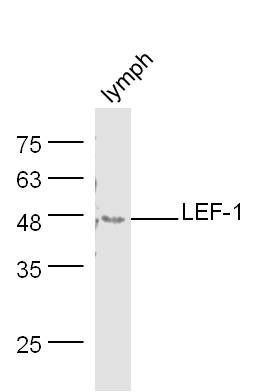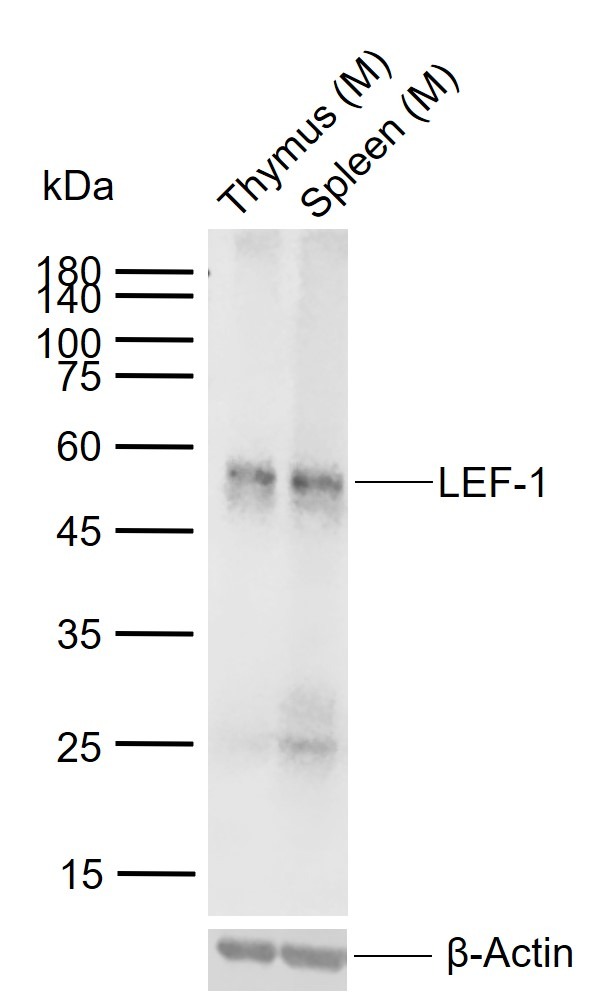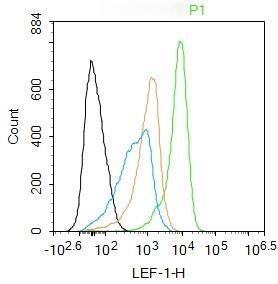Shopping Cart
Remove All Your shopping cart is currently empty
Your shopping cart is currently empty
Anti-LEF1 Polyclonal Antibody is a Rabbit antibody targeting LEF1. Anti-LEF1 Polyclonal Antibody can be used in FCM,WB.
| Pack Size | Price | USA Warehouse | Global Warehouse | Quantity |
|---|---|---|---|---|
| 50 μL | $222 | 7-10 days | 7-10 days | |
| 100 μL | $373 | 7-10 days | 7-10 days | |
| 200 μL | $529 | 7-10 days | 7-10 days |
| Description | Anti-LEF1 Polyclonal Antibody is a Rabbit antibody targeting LEF1. Anti-LEF1 Polyclonal Antibody can be used in FCM,WB. |
| Synonyms | TCF1-alpha, T cell-specific transcription factor 1-alpha, Lymphoid enhancer-binding factor 1, LEF-1 |
| Ig Type | IgG |
| Reactivity | Human,Mouse (predicted:Rat,Chicken,Dog,Pig,Cow,Rabbit) |
| Verified Activity | 1. Sample: LympHnodes (Mouse) Lysate at 30 μg Primary: Anti-LEF-1 (TMAB-01058) at 1/300 dilution Secondary: IRDye800CW Goat Anti-Mouse IgG at 1/10000 dilution Predicted band size: 44 kDa Observed band size: 47 kDa 2. Sample: Lane 1: Mouse Thymus tissue lysates Lane 2: Mouse Spleen tissue lysates Primary: Anti-LEF-1 (TMAB-01058) at 1/1000 dilution Secondary: IRDye800CW Goat Anti-Rabbit IgG at 1/20000 dilution Predicted band size: 44 kDa Observed band size: 55 kDa 3. Blank control (black line): Molt4. Primary Antibody (green line): Rabbit Anti-LEF-1 antibody (TMAB-01058) Dilution: 1 μg/Test; Secondary Antibody: Goat anti-rabbit IgG-AF488 Dilution: 0.5 μg/Test. Negative control (white blue line): PBS Isotype control (orange line): Normal Rabbit IgG Protocol The cells were fixed with 4% PFA (10 min at room temperature) and then permeabilized with 90% ice-cold methanol for 20 min at-20°C. The cells were then incubated in 5% BSA to block non-specific protein-protein interactions for 30 min at room temperature. Cells stained with Primary Antibody for 30 min at room temperature. The secondary antibody used for 40 min at room temperature.    |
| Application | |
| Recommended Dose | WB: 1:500-2000; FCM: 1ug/test |
| Antibody Type | Polyclonal |
| Host Species | Rabbit |
| Subcellular Localization | Nucleus. Note=Found in nuclear bodies upon PIASG binding. |
| Tissue Specificity | Detected in thymus. Not detected in normal colon, but highly expressed in colon cancer biopsies and colon cancer cell lines. Expressed in several pancreatic tumors and weakly expressed in normal pancreatic tissue. Isoforms 1 and 5 are detected in several |
| Construction | Polyclonal Antibody |
| Purification | Protein A purified |
| Appearance | Liquid |
| Formulation | 0.01M TBS (pH7.4) with 1% BSA, 0.02% Proclin300 and 50% Glycerol. |
| Concentration | 1 mg/mL |
| Research Background | This gene encodes a transcription factor belonging to a family of proteins that share homology with the high mobility group protein-1. The protein encoded by this gene can bind to a functionally important site in the T-cell receptor-alpha enhancer, thereby conferring maximal enhancer activity. This transcription factor is involved in the Wnt signaling pathway, and it may function in hair cell differentiation and follicle morphogenesis. Mutations in this gene have been found in somatic sebaceous tumors. This gene has also been linked to other cancers, including androgen-independent prostate cancer. Alternative splicing results in multiple transcript variants. [provided by RefSeq, Oct 2009]. |
| Immunogen | KLH conjugated synthetic peptide: human LEF-1 |
| Antigen Species | Human |
| Gene Name | LEF1 |
| Gene ID | |
| Protein Name | Lymphoid enhancer-binding factor 1 |
| Uniprot ID | |
| Biology Area | PTC & Wnt pathway,Mesoderm,HMG Box,Transcription Factors,Mesoderm,Nuclear |
| Function | Participates in the Wnt signaling pathway. Activates transcription of target genes in the presence of CTNNB1 and EP300. May play a role in hair cell differentiation and follicle morphogenesis. TLE1, TLE2, TLE3 and TLE4 repress transactivation mediated by LEF1 and CTNNB1. Regulates T-cell receptor alpha enhancer function. Binds DNA in a sequence-specific manner. PIAG antagonizes both Wnt-dependent and Wnt-independent activation by LEF1 (By similarity). Isoform 3 lacks the CTNNB1 interaction domain and may be an antagonist for Wnt signaling. Isoform 5 transcriptionally activates the fibronectin promoter, binds to and represses transcription from the E-cadherin promoter in a CTNNB1-independent manner, and is involved in reducing cellular aggregation and increasing cell migration of pancreatic cancer cells. Isoform 1 transcriptionally activates MYC and CCND1 expression and enhances proliferation of pancreatic tumor cells. |
| Molecular Weight | Theoretical: 44 kDa. |
| Stability & Storage | Store at -20°C or -80°C for 12 months. Avoid repeated freeze-thaw cycles. |
| Transport | Shipping with blue ice. |
| Size | Quantity | Unit Price | Amount | Operation |
|---|

Copyright © 2015-2026 TargetMol Chemicals Inc. All Rights Reserved.